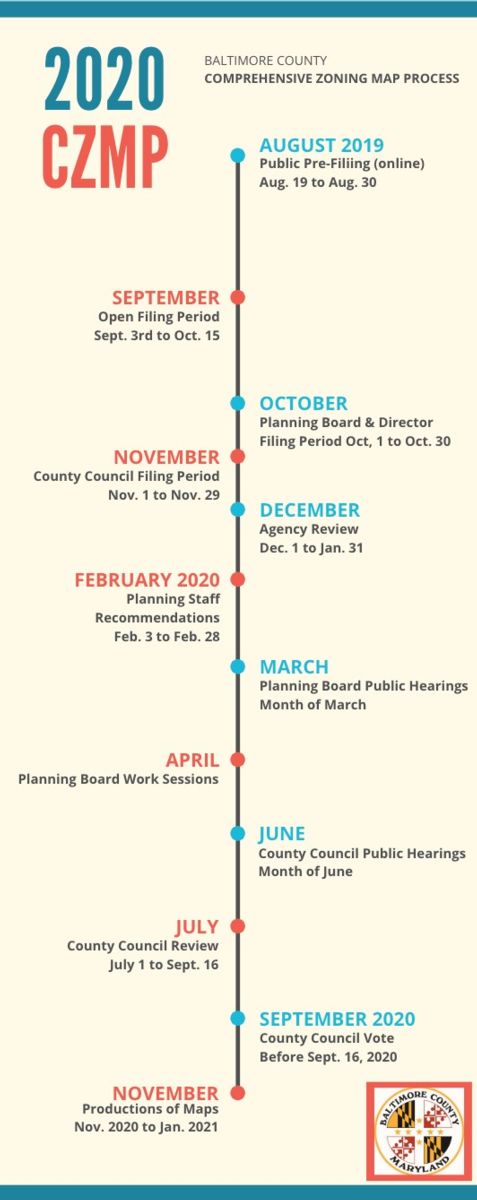The Real Deal - Summer 2019 Issue
Opportunity is Knocking (at least in Baltimore County)
By: Jennifer R. BusseAnyone active in the Baltimore County development arena is aware that the process never gets easier. Regulations continue to tighten, communities continue to protest development, and costs continue to rise. Earlier this summer, facing budget shortfalls, the Baltimore County Council passed legislation instituting impact fees on residential development and development impact surcharges on nonresidential and multi-family development. (Reach out to us if you have any concerns on the impact of this legislation on any of your projects!) As the saying goes, the only thing that remains constant is change.
Scouring for opportunities is a developer’s specialty, and risk is inherent in the development business. So naturally, Baltimore County’s quadrennial Comprehensive Zoning Map Process (“CZMP”) is a much anticipated event. This upcoming 2020 cycle kicks off with the online public pre-filing period, opening on August 19th and running through August 30th. Forms and links have yet to be released, but the fees have been published. Filing early saves some money, and as in past years, community associations get a big discount.
The Baltimore County CZMP is about a year long process since by law the County Council has to vote on all zoning requests by September 16, 2020. (Exact date for this cycle’s vote is yet to be determined.) Between now and then though, there are many steps along the way. After the public has its filing period, the Planning Staff, Planning Board and County Council each get their windows of opportunity.
Three very important things to remember:
#1 - Anyone can put anyone’s property in play. (Yes, this continues to shock the conscience.)
#2 - Once property is in play, it is at risk for a zoning change. The filing of a zoning request results in the creation of an “Issue”. And once an Issue is filed, it CANNOT be withdrawn.
#3 - While the applicant for a zoning request may seek to up-zone property, the Council can vote to do whatever they want. They can down-zone or up-zone property. And, zoning lines need NOT follow property lines so the Council can even split zone property.
Another thing to keep in mind, if you are considering developing property and have not yet filed the concept plan or limited exemption request, you may want to do so before September 1, 2019. Otherwise, if a CZMP Issue is filed for your property by the Planning Staff, Planning Board or County Council, you will not be able to vest the project until after the legislation goes into effect for the new zoning maps. There are a host of things to consider in this regard and we encourage you to reach out to talk the impact of timing decision through carefully.
The Planning Department has just published some additional filing information. The on-line zoning application will have to include not only the tax account and property identifiers for the properties for which zoning is requested, but also all prior zoning history. Supporting documentation may include site plans of the property, deed to the property and photos and letters in support of the requested zoning. After an application has been filed on-line, the Planning Department will set up an appointment for the official filing at which time the fee for the filing will be due. Only after the Planning Department has signed off on the application will the request become official.
So, let the fun begin.
Don’t hesitate to reach out to John B. Gontrum (410-832-2055; jgontrum@wtplaw.com) with any questions or if you wish to bounce around ideas for potential CZMP Issues.

Opportunity Zone Regulations: Round 2
By: Jordan M. Halle
“Good things come to those who wait…”
At long last, on April 17, 2019, Treasury released its second set of proposed regulations providing guidance on Opportunity Zones. (Available here). These proposed regulations answer some questions about how operating businesses can take advantage of the Opportunity Zones. Of particular note and as highlighted below, Treasury provided much needed guidance and flexibility regarding leased property.
One of the key questions for operating businesses positioning themselves for investment as Qualified Opportunity Zone Businesses was how leased property would be treated under the regulations. The regulations propose two general criteria which must be met for leased tangible property to satisfy the 90% asset test (§1400Z-2(d)(1)) or the “substantially all” test (§1400Z-2(d)(3)(A)(i)): (1) leased property must be acquired under a lease entered into after December 31, 2017, and (2) substantially all of the use must be in the Opportunity Zone during “substantially all” of the lease period.
Leased property is no longer subject to the “original use” requirement or the “substantial improvement” requirement, and the property can be leased from a related party.
Any lease must be a “market rate lease,” as determined under §482. Additionally, if the lessor and lessee are related: (1) the lessee cannot make a prepayment for a period of use exceeding 12 months and (2) the lessee must purchase tangible qualified Opportunity Zone Business Property with a value equal to or greater than the value of the lessee’s leased personalproperty (the regulations include methodologies for valuing the leased personal property).
In general, this set of regulations is favorable to making operating business investments in Opportunity Zones by enabling a broad range of businesses to qualify as Opportunity Zone Businesses.
Aggressive planners should be aware that these regulations include an anti-abuse provision that permits Treasury officials to revoke a tax break for any Opportunity Zone project “if a significant purpose of a transaction is to achieve a tax result that is inconsistent with the purposes” of the program. While the design of the program generally requires self-reporting of qualifications, it is important to ensure that Opportunity Zone projects are structured to meet the requirements of the regulations.
For more general information about the Opportunity Zone program, please refer to our earlier article, What You Should Know About Qualified Opportunity Zones.

